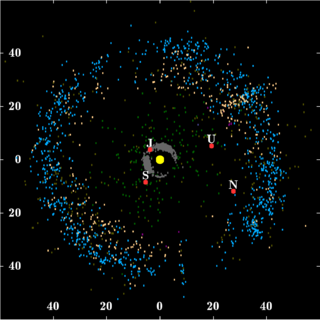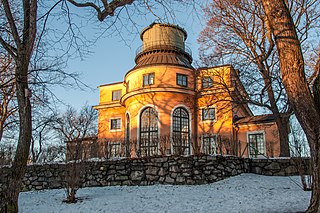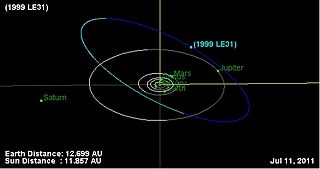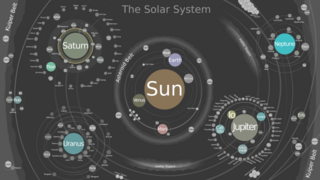
A comet is an icy, small Solar System body that warms and begins to release gases when passing close to the Sun, a process called outgassing. This produces an extended, gravitationally unbound atmosphere or coma surrounding the nucleus, and sometimes a tail of gas and dust gas blown out from the coma. These phenomena are due to the effects of solar radiation and the outstreaming solar wind plasma acting upon the nucleus of the comet. Comet nuclei range from a few hundred meters to tens of kilometers across and are composed of loose collections of ice, dust, and small rocky particles. The coma may be up to 15 times Earth's diameter, while the tail may stretch beyond one astronomical unit. If sufficiently close and bright, a comet may be seen from Earth without the aid of a telescope and can subtend an arc of up to 30° across the sky. Comets have been observed and recorded since ancient times by many cultures and religions.

The Kuiper belt is a circumstellar disc in the outer Solar System, extending from the orbit of Neptune at 30 astronomical units (AU) to approximately 50 AU from the Sun. It is similar to the asteroid belt, but is far larger—20 times as wide and 20–200 times as massive. Like the asteroid belt, it consists mainly of small bodies or remnants from when the Solar System formed. While many asteroids are composed primarily of rock and metal, most Kuiper belt objects are composed largely of frozen volatiles, such as methane, ammonia, and water. The Kuiper belt is home to most of the objects that astronomers generally accept as dwarf planets: Orcus, Pluto, Haumea, Quaoar, and Makemake. Some of the Solar System's moons, such as Neptune's Triton and Saturn's Phoebe, may have originated in the region.

Following the discovery of the planet Neptune in 1846, there was considerable speculation that another planet might exist beyond its orbit. The search began in the mid-19th century and continued at the start of the 20th with Percival Lowell's quest for Planet X. Lowell proposed the Planet X hypothesis to explain apparent discrepancies in the orbits of the giant planets, particularly Uranus and Neptune, speculating that the gravity of a large unseen ninth planet could have perturbed Uranus enough to account for the irregularities.

The Solar System is the gravitationally bound system of the Sun and the objects that orbit it. The largest of these objects are the eight planets, which in order from the Sun are four terrestrial planets ; two gas giants ; and two ice giants. The Solar System developed 4.6 billion years ago when a dense region of a molecular cloud collapsed, forming the Sun and a protoplanetary disc.

The Jupiter trojans, commonly called trojan asteroids or simply trojans, are a large group of asteroids that share the planet Jupiter's orbit around the Sun. Relative to Jupiter, each trojan librates around one of Jupiter's stable Lagrange points: either L4, existing 60° ahead of the planet in its orbit, or L5, 60° behind. Jupiter trojans are distributed in two elongated, curved regions around these Lagrangian points with an average semi-major axis of about 5.2 AU.

Uranus is the seventh planet from the Sun. It is a gaseous cyan-coloured ice giant. Most of the planet is made of water, ammonia, and methane in a supercritical phase of matter, which in astronomy is called 'ice' or volatiles. The planet's atmosphere has a complex layered cloud structure and has the lowest minimum temperature of 49 K out of all the Solar System's planets. It has a marked axial tilt of 82.23° with a retrograde rotation period of 17 hours and 14 minutes. This means that in an 84-Earth-year orbital period around the Sun, its poles get around 42 years of continuous sunlight, followed by 42 years of continuous darkness.

2060 Chiron is a small Solar System body in the outer Solar System, orbiting the Sun between Saturn and Uranus. Discovered in 1977 by Charles Kowal, it was the first-identified member of a new class of objects now known as centaurs—bodies orbiting between the asteroid belt and the Kuiper belt.

Lowell Observatory is an astronomical observatory in Flagstaff, Arizona, United States. Lowell Observatory was established in 1894, placing it among the oldest observatories in the United States, and was designated a National Historic Landmark in 1965. In 2011, the Observatory was named one of "The World's 100 Most Important Places" by Time Magazine. It was at the Lowell Observatory that the dwarf planet Pluto was discovered in 1930 by Clyde Tombaugh.

944 Hidalgo is a centaur and unusual object on an eccentric, cometary-like orbit between the asteroid belt and the outer Solar System, approximately 52 kilometers in diameter. Discovered by German astronomer Walter Baade in 1920, it is the first member of the dynamical class of centaurs ever to be discovered. The dark D-type object has a rotation period of 10.1 hours and likely an elongated shape. It was named after Mexican revolutionary Miguel Hidalgo y Costilla.

The Stockholm Observatory is an astronomical observatory and institution in Stockholm, Sweden, founded in the 18th century and today part of Stockholm University. In 1931, the new Stockholm Observatory, nicknamed "Saltis", was inaugurated on the Karlsbaderberget at Saltsjöbaden, near Stockholm, and operated until 2001.
Nine Views is an ambiental installation in Zagreb, Croatia which, together with the sculpture Prizemljeno Sunce, comprises a scale model of the Solar System.

The scattered disc (or scattered disk) is a distant circumstellar disc in the Solar System that is sparsely populated by icy small Solar System bodies, which are a subset of the broader family of trans-Neptunian objects. The scattered-disc objects (SDOs) have orbital eccentricities ranging as high as 0.8, inclinations as high as 40°, and perihelia greater than 30 astronomical units (4.5×109 km; 2.8×109 mi). These extreme orbits are thought to be the result of gravitational "scattering" by the gas giants, and the objects continue to be subject to perturbation by the planet Neptune.
(5335) Damocles, provisional designation 1991 DA, is a centaur and the namesake of the damocloids, a group of minor planets which may be inactive nuclei of the Halley-type and long-period comets. It was discovered on 18 February 1991, by Australian astronomer Robert McNaught at Siding Spring Observatory in Australia. It is named after Damocles, a figure of Greek mythology.

Discovery and exploration of the Solar System is observation, visitation, and increase in knowledge and understanding of Earth's "cosmic neighborhood". This includes the Sun, Earth and the Moon, the major planets Mercury, Venus, Mars, Jupiter, Saturn, Uranus, and Neptune, their satellites, as well as smaller bodies including comets, asteroids, and dust.

Minimum orbit intersection distance (MOID) is a measure used in astronomy to assess potential close approaches and collision risks between astronomical objects. It is defined as the distance between the closest points of the osculating orbits of two bodies. Of greatest interest is the risk of a collision with Earth. Earth MOID is often listed on comet and asteroid databases such as the JPL Small-Body Database. MOID values are also defined with respect to other bodies as well: Jupiter MOID, Venus MOID and so on.

(612093) 1999 LE31, prov. designation: 1999 LE31, is a centaur and damocloid on a retrograde and eccentric orbit from the outer region of the Solar System. It was first observed on 12 June 1999, by astronomers with the LINEAR program at the Lincoln Lab's ETS near Socorro, New Mexico, in the United States. The unusual object measures approximately 17 kilometers (11 miles) in diameter.

The Sciencenter's Sagan Planet Walk is a walkable scale model of the Solar System, located in Ithaca, New York. The model scales the entire Solar System—both planet size and distances between them—down to one five billionth of its actual size. The exhibition was originally created in 1997 in memory of Ithaca resident and Cornell Professor Carl Sagan.

The following outline is provided as an overview of and topical guide to the Solar System:

2012 DR30 is a trans-Neptunian object and centaur from the scattered disk and/or inner Oort cloud, located in the outermost region of the Solar System. The object with a highly eccentric orbit of 0.99 was first observed by astronomers with the Spacewatch program at Steward Observatory on 31 March 2009. It measures approximately 188 kilometers (120 miles) in diameter.































